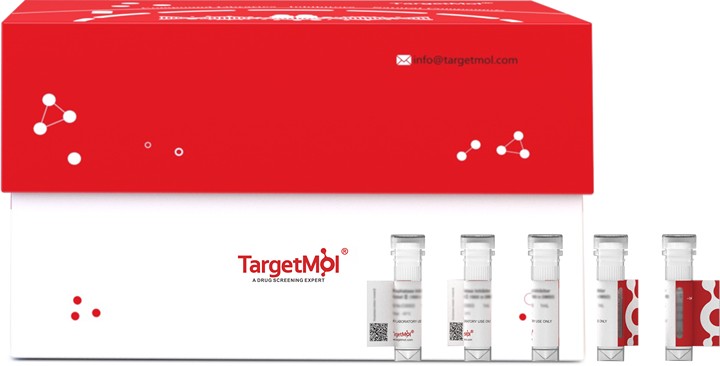 您的购物车当前为空
您的购物车当前为空
DNA-binding protein H-NS Protein, E. coli, Recombinant (His)
一键复制产品信息别名 topS, Protein H1, Protein B1, pilG, osmZ, msyA, hnsA, h-ns, hns, Histone-like protein HLP-II, Heat-stable nucleoid-structuring protein, drdX, DNA-binding protein H-NS, cur, bglY
A DNA-binding protein implicated in transcriptional repression (silencing). Also involved in bacterial chromosome organization and compaction. H-NS binds tightly to AT-rich dsDNA and inhibits transcription. Binds upstream and downstream of initiating RNA polymerase, trapping it in a loop and preventing transcription. Binds to hundreds of sites, approximately half its binding sites are in non-coding DNA, which only accounts for about 10% of the genome. Many of these loci were horizontally transferred (HTG); this offers the selective advantage of silencing foreign DNA while keeping it in the genome in case of need. Suppresses transcription at many intragenic sites as well as transcription of spurious, non-coding RNAs genome-wide. Repression of HTG by H-NS is thought to allow their DNA to evolve faster than non-H-NS-bound regions, and facilitates integration of HTG into transcriptional regulatory networks. A subset of H-NS/StpA-regulated genes also require Hha (and/or Cnu, ydgT) for repression; Hha and Cnu increase the number of genes DNA bound by H-NS/StpA and may also modulate the oligomerization of the H-NS/StpA-complex. The protein forms 2 clusters in the nucleoid which gather hns-bound loci together, bridging non-contiguous DNA, and causes DNA substantial condensation. Binds DNA better at low temperatures than at 37 degrees Celsius; AT-rich sites nucleate H-NS binding, further DNA-binding is cooperative and this cooperativity decreases with rising temperature. Transcriptional repression can be inhibited by dominant-negative mutants of StpA or itself. May effect transcriptional elongation. Can increase translational efficiency of mRNA with suboptimal Shine-Dalgarno sequences. Plays a role in the thermal control of pili and adhesive curli fimbriae production, by inducing transcription of csgD. Plays a role in flagellar function. Represses the CRISPR-cas promoters, permits only weak transcription of the crRNA precursor; its repression is antagonized by LeuO. Binds preferentially to the upstream region of its own gene recognizing two segments of DNA on both sides of a bend centered around -150. Overexpression suppresses secY24, a temperature-sensitive mutation. Has also been reported to activate transcription of some genes.


为众多的药物研发团队赋能,
让新药发现更简单!
DNA-binding protein H-NS Protein, E. coli, Recombinant (His)
一键复制产品信息A DNA-binding protein implicated in transcriptional repression (silencing). Also involved in bacterial chromosome organization and compaction. H-NS binds tightly to AT-rich dsDNA and inhibits transcription. Binds upstream and downstream of initiating RNA polymerase, trapping it in a loop and preventing transcription. Binds to hundreds of sites, approximately half its binding sites are in non-coding DNA, which only accounts for about 10% of the genome. Many of these loci were horizontally transferred (HTG); this offers the selective advantage of silencing foreign DNA while keeping it in the genome in case of need. Suppresses transcription at many intragenic sites as well as transcription of spurious, non-coding RNAs genome-wide. Repression of HTG by H-NS is thought to allow their DNA to evolve faster than non-H-NS-bound regions, and facilitates integration of HTG into transcriptional regulatory networks. A subset of H-NS/StpA-regulated genes also require Hha (and/or Cnu, ydgT) for repression; Hha and Cnu increase the number of genes DNA bound by H-NS/StpA and may also modulate the oligomerization of the H-NS/StpA-complex. The protein forms 2 clusters in the nucleoid which gather hns-bound loci together, bridging non-contiguous DNA, and causes DNA substantial condensation. Binds DNA better at low temperatures than at 37 degrees Celsius; AT-rich sites nucleate H-NS binding, further DNA-binding is cooperative and this cooperativity decreases with rising temperature. Transcriptional repression can be inhibited by dominant-negative mutants of StpA or itself. May effect transcriptional elongation. Can increase translational efficiency of mRNA with suboptimal Shine-Dalgarno sequences. Plays a role in the thermal control of pili and adhesive curli fimbriae production, by inducing transcription of csgD. Plays a role in flagellar function. Represses the CRISPR-cas promoters, permits only weak transcription of the crRNA precursor; its repression is antagonized by LeuO. Binds preferentially to the upstream region of its own gene recognizing two segments of DNA on both sides of a bend centered around -150. Overexpression suppresses secY24, a temperature-sensitive mutation. Has also been reported to activate transcription of some genes.
| 规格 | 价格 | 库存 | 数量 |
|---|---|---|---|
| 5 μg | ¥ 825 | 20日内发货 | |
| 10 μg | ¥ 1,360 | 20日内发货 | |
| 20 μg | ¥ 2,290 | 20日内发货 | |
| 50 μg | ¥ 3,460 | 20日内发货 | |
| 100 μg | ¥ 4,750 | 20日内发货 | |
| 200 μg | ¥ 6,830 | 20日内发货 | |
| 500 μg | ¥ 10,800 | 20日内发货 | |
| 1 mg | ¥ 16,000 | 20日内发货 |
产品介绍
| 产品描述 | A DNA-binding protein implicated in transcriptional repression (silencing). Also involved in bacterial chromosome organization and compaction. H-NS binds tightly to AT-rich dsDNA and inhibits transcription. Binds upstream and downstream of initiating RNA polymerase, trapping it in a loop and preventing transcription. Binds to hundreds of sites, approximately half its binding sites are in non-coding DNA, which only accounts for about 10% of the genome. Many of these loci were horizontally transferred (HTG); this offers the selective advantage of silencing foreign DNA while keeping it in the genome in case of need. Suppresses transcription at many intragenic sites as well as transcription of spurious, non-coding RNAs genome-wide. Repression of HTG by H-NS is thought to allow their DNA to evolve faster than non-H-NS-bound regions, and facilitates integration of HTG into transcriptional regulatory networks. A subset of H-NS/StpA-regulated genes also require Hha (and/or Cnu, ydgT) for repression; Hha and Cnu increase the number of genes DNA bound by H-NS/StpA and may also modulate the oligomerization of the H-NS/StpA-complex. The protein forms 2 clusters in the nucleoid which gather hns-bound loci together, bridging non-contiguous DNA, and causes DNA substantial condensation. Binds DNA better at low temperatures than at 37 degrees Celsius; AT-rich sites nucleate H-NS binding, further DNA-binding is cooperative and this cooperativity decreases with rising temperature. Transcriptional repression can be inhibited by dominant-negative mutants of StpA or itself. May effect transcriptional elongation. Can increase translational efficiency of mRNA with suboptimal Shine-Dalgarno sequences. Plays a role in the thermal control of pili and adhesive curli fimbriae production, by inducing transcription of csgD. Plays a role in flagellar function. Represses the CRISPR-cas promoters, permits only weak transcription of the crRNA precursor; its repression is antagonized by LeuO. Binds preferentially to the upstream region of its own gene recognizing two segments of DNA on both sides of a bend centered around -150. Overexpression suppresses secY24, a temperature-sensitive mutation. Has also been reported to activate transcription of some genes. |
| 生物活性 | Activity has not been tested. It is theoretically active, but we cannot guarantee it. If you require protein activity, we recommend choosing the eukaryotic expression version first. |
| 研究背景 | A DNA-binding protein implicated in transcriptional repression (silencing). Also involved in bacterial chromosome organization and compaction. H-NS binds tightly to AT-rich dsDNA and inhibits transcription. Binds upstream and downstream of initiating RNA polymerase, trapping it in a loop and preventing transcription. Binds to hundreds of sites, approximately half its binding sites are in non-coding DNA, which only accounts for about 10% of the genome. Many of these loci were horizontally transferred (HTG); this offers the selective advantage of silencing foreign DNA while keeping it in the genome in case of need. Suppresses transcription at many intragenic sites as well as transcription of spurious, non-coding RNAs genome-wide. Repression of HTG by H-NS is thought to allow their DNA to evolve faster than non-H-NS-bound regions, and facilitates integration of HTG into transcriptional regulatory networks. A subset of H-NS/StpA-regulated genes also require Hha (and/or Cnu, ydgT) for repression; Hha and Cnu increase the number of genes DNA bound by H-NS/StpA and may also modulate the oligomerization of the H-NS/StpA-complex. The protein forms 2 clusters in the nucleoid which gather hns-bound loci together, bridging non-contiguous DNA, and causes DNA substantial condensation. Binds DNA better at low temperatures than at 37 degrees Celsius; AT-rich sites nucleate H-NS binding, further DNA-binding is cooperative and this cooperativity decreases with rising temperature. Transcriptional repression can be inhibited by dominant-negative mutants of StpA or itself. May effect transcriptional elongation. Can increase translational efficiency of mRNA with suboptimal Shine-Dalgarno sequences. Plays a role in the thermal control of pili and adhesive curli fimbriae production, by inducing transcription of csgD. Plays a role in flagellar function. Represses the CRISPR-cas promoters, permits only weak transcription of the crRNA precursor; its repression is antagonized by LeuO. Binds preferentially to the upstream region of its own gene recognizing two segments of DNA on both sides of a bend centered around -150. Overexpression suppresses secY24, a temperature-sensitive mutation. Has also been reported to activate transcription of some genes. |
| 种属 | E. coli |
| 表达系统 | E. coli |
| 标签 | N-6xHis |
| 蛋白编号 | P0ACF8 |
| 氨基酸序列 | SEALKILNNIRTLRAQARECTLETLEEMLEKLEVVVNERREEESAAAAEVEERTRKLQQYREMLIADGIDPNELLNSLAAVKSGTKAKRAQRPAKYSYVDENGETKTWTGQGRTPAVIKKAMDEQGKSLDDFLIKQ |
| 蛋白构建 | 2-137 aa |
| 蛋白纯度 | > 85% as determined by SDS-PAGE. |
| 缓冲液 | Tris-based buffer, 50% glycerol |
| 复溶方法 | A Certificate of Analysis (CoA) containing reconstitution instructions is included with the products. Please refer to the CoA for detailed information. |
| 别名 | topS, Protein H1, Protein B1, pilG, osmZ, msyA, hnsA, h-ns, hns, Histone-like protein HLP-II, Heat-stable nucleoid-structuring protein, drdX, DNA-binding protein H-NS, cur, bglY |
| 内毒素 | < 1.0 EU/μg of the protein as determined by the LAL method. |
| 分子量 | 19.5 kDa (predicted) |
| 运输方式 | In general, Lyophilized powders are shipping with blue ice. Solutions are shipping with dry ice. |
| 存储 | Lyophilized powders can be stably stored for over 12 months, while liquid products can be stored for 6-12 months at -80°C. For reconstituted protein solutions, the solution can be stored at -20°C to -80°C for at least 3 months. Please avoid multiple freeze-thaw cycles and store products in aliquots. |
计算器
剂量转换
对于不同动物的给药剂量换算,您也可以参考 更多





 还可以
还可以
 |
|